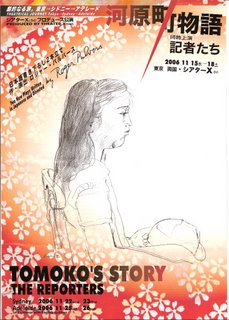 Event: Tomoko's Story, The Reporters, Roger Pulvers (writer/director), Parade Studio, NIDA
Event: Tomoko's Story, The Reporters, Roger Pulvers (writer/director), Parade Studio, NIDATightly scripted, these plays are a delight. So tightly scripted that, having imbibed three beers before the performance and at interval, I had to duck out to relieve myself near the end of the second performance — Tomoko's Story — and missed some key action.
But I enjoyed myself immensely. With a big grin of my face, I guffawed as Yutaka Nagahata, playing Pedro in The Reporters and Hidetaro in Tomoko's Story, clowned dyspeptically about the stage. The surtitles came in handy, even for me. But it was the living, breathing essence of Japanese that I enjoyed so much. Pulvers is a very talented writer.
The Reporters is a comic piece with dark edges that features two reporters in a tin-pot Central- or South-American state who are caught up in a revolution. But the action is in their political affiliations. Mary, played by Koko Furuta, is an American reporter who writes for a right-wing newspaper, but actually sympathises with the Communists. Li Gung Ho, played by Kenjiro Otani, is a Chinese reporter who actually likes the capitalist way of life. They knew each other before meeting, here, in a little cafe hosted by the taciturn Pedro. Inspired by their own duplicity, they each decide to write a piece for the other. Their productions are complimented by the head offices. Finally, throwing caution to the wind, they decide to swap lives, houses, everything. Li-san wants to live near Disney World in Florida. Mary is looking forward to meeting up with her boyfriend in Beijing.
Tomoko's Story is more complex and darker. The edges in this piece are brightened by Nagahata, who masterfully plays the 'master' of a little coffee shop in Kyoto called 'Island'. Avuncular and with a shadowy past, Hidetaro hosts the meeting of Tomoko and Frank, a GI on R&R from Vietnam. Tomoko is a student who doesn't go to classes, and whose most precious possession is a signed copy of a book by William Faulkner, that the writer had presented to her when she was a girl. Frank swears by his St Christopher medal. He persuades Tomoko to exchange treasures with him. He also gives Hidetaro modern pop music records, and Tomoko a portrait of James Dean.
But Tomoko is never at ease with Frank. She's a cagey one, and resents this intrusion on her personal space. She also carries some heavy emotional baggage. As a girl, she had gone to Illinois to school, and recalls the bullying she endured at the hands of white kids, because of her race. At Island, she finds peace, and the impersonal friendship of the master, Hidetaro, is congenial to her.
Frank is looking for something. Unfortunately, I missed some important stuff. But the rape changes everything.
There are also two flashbacks, which are handled adroitly. With only three actors on stage, the performance fairly shoots along. With minimal props, the audience is invited to suspend disbelief, and immerse themselves in the poetry of the play. Very memorable.
I left home at 7:00 p.m. and took the M5 motorway out to Kensington. I walked in the theatre doors at 7:30, having parked in High Street, near the entrance to the Australian Jockey Club.
The performance now moves to Adelaide, where it will be staged on Saturday and Sunday at the Hartley Playhouse, University of South Australia. Recommended.
No comments:
Post a Comment